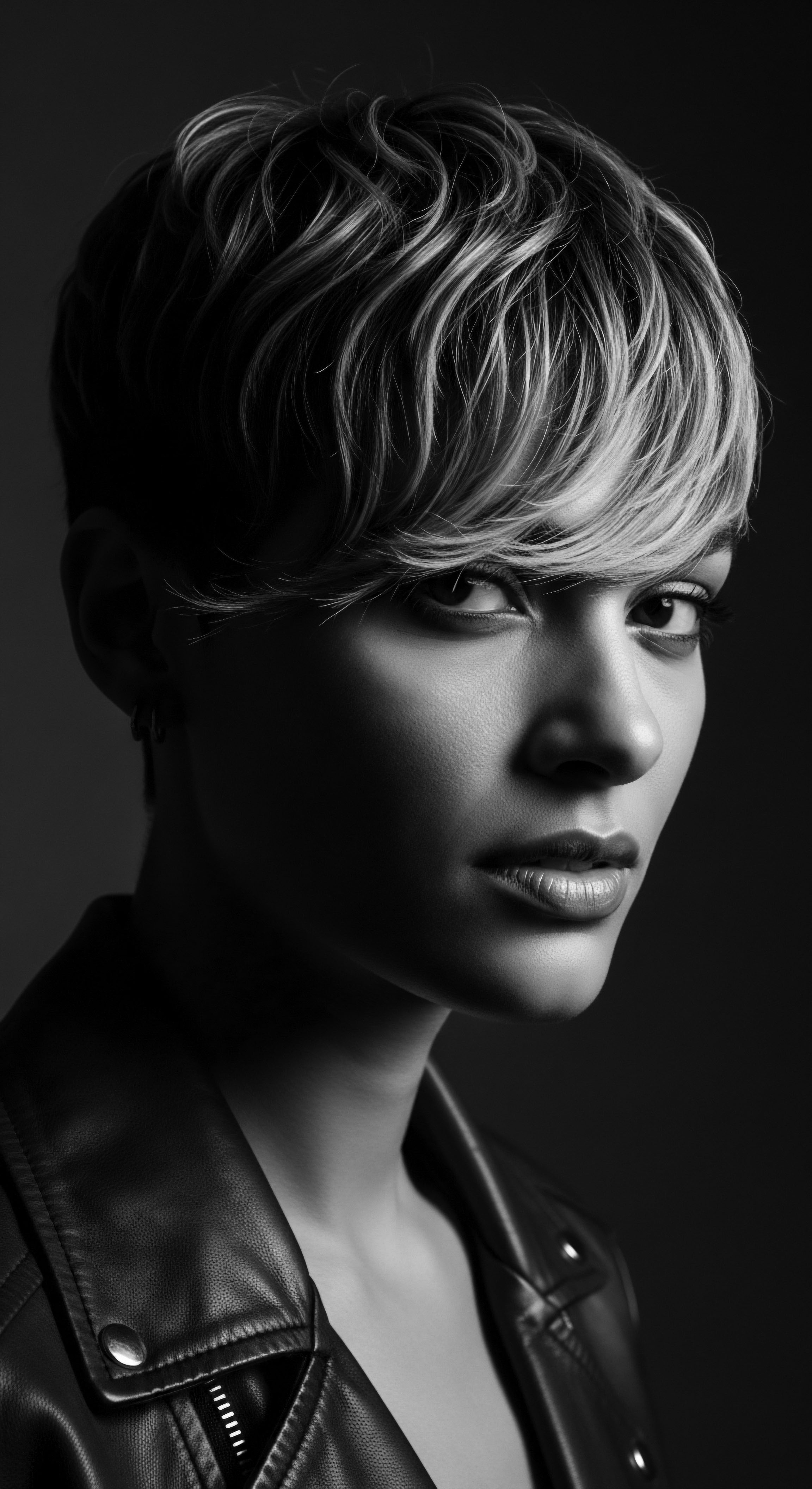
Fundamentals
The concept of Chemical Hair Straightening, at its foundational level, refers to a process that intentionally alters the inherent structure of hair strands to achieve a smoother, more elongated form. This transformation relies upon chemical agents that work to disrupt the natural curl or coil patterns present in hair. It is a deliberate modification, moving hair from its original textured state to one that appears visibly straighter. For many, particularly those with hair textures that coil tightly or form intricate patterns, this practice has held various meanings throughout history, ranging from a matter of convenience to a complex expression of identity.
From the earliest days of its widespread application, the methods employed in chemical hair straightening have sought to reconfigure the very building blocks of the hair shaft. Hair, composed primarily of a protein called keratin, possesses disulfide bonds that largely dictate its shape. These bonds, when numerous and strategically placed, give rise to the beautiful, resilient spirals and zigzags characteristic of textured hair.
Chemical straightening agents, in their most basic action, work to sever these bonds, allowing the hair to be reshaped into a straighter configuration. Once the bonds are broken, the hair is then typically rinsed and neutralized, permitting new bonds to form in the desired, straightened alignment.
The initial perception of chemical hair straightening, especially within communities with textured hair, often centered on practical considerations. Managing highly coiled hair could be time-consuming, and for some, the desire for a less demanding styling routine was a driving force. Yet, even at this basic level of understanding, the practice was never solely about ease. It quickly became intertwined with broader societal expectations and the silent pressures that shape perceptions of beauty and acceptance.
Chemical Hair Straightening, at its core, is a process that reshapes hair’s natural form by altering its protein bonds, a practice often steeped in complex historical and cultural contexts for textured hair.
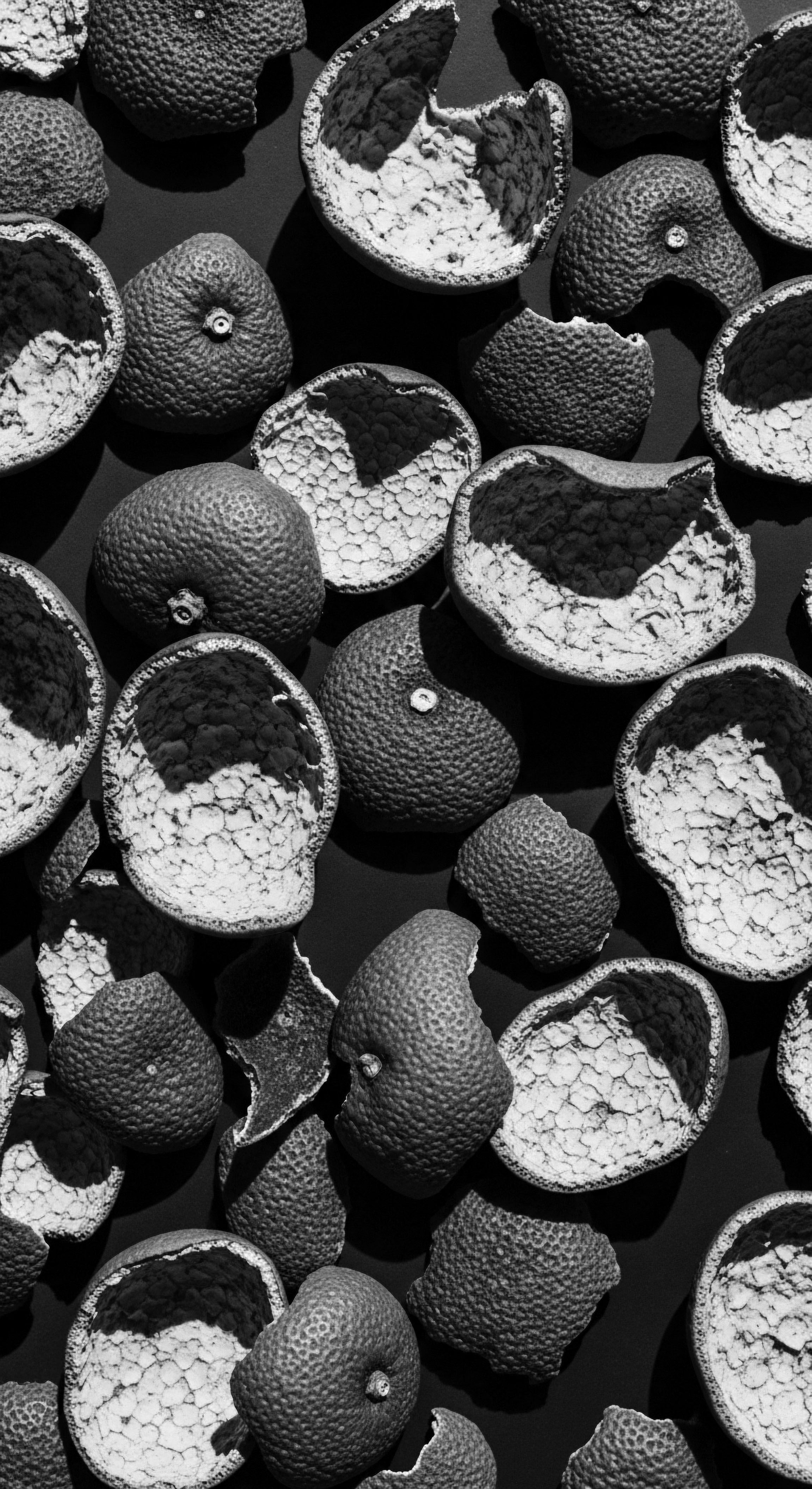
Early Historical Echoes of Hair Alteration
Long before the advent of modern chemical formulations, ancestral communities across the African continent practiced various forms of hair alteration, though distinct from the chemical straightening known today. These practices were often ceremonial, social, or protective, utilizing natural ingredients and heat from fires. For instance, some communities might use specific clays or natural oils in conjunction with tension to temporarily elongate strands, a testament to an ancient understanding of hair malleability. These were not about permanent structural change but about presentation and care, reflecting deep respect for hair as a spiritual and social conduit.
The journey of hair, from its elemental biology to its profound cultural significance, truly begins with an appreciation for its inherent diversity. Textured hair, with its unique patterns and strengths, has always been a crown of heritage. Understanding chemical hair straightening necessitates acknowledging the ancestral hands that first sought to style, adorn, and care for hair, even without the chemical knowledge we possess today. These early traditions, though rudimentary by contemporary scientific standards, represent the genesis of hair care as a deliberate act of self-expression and community connection.
The earliest iterations of chemical hair straightening, as they developed, did not spring from a void. They emerged from a historical continuum where hair, especially within Black and mixed-race communities, held profound significance. The longing for manageability or a particular aesthetic, even when driven by external pressures, often echoed a deeper, perhaps unconscious, connection to hair as a medium for self-presentation.
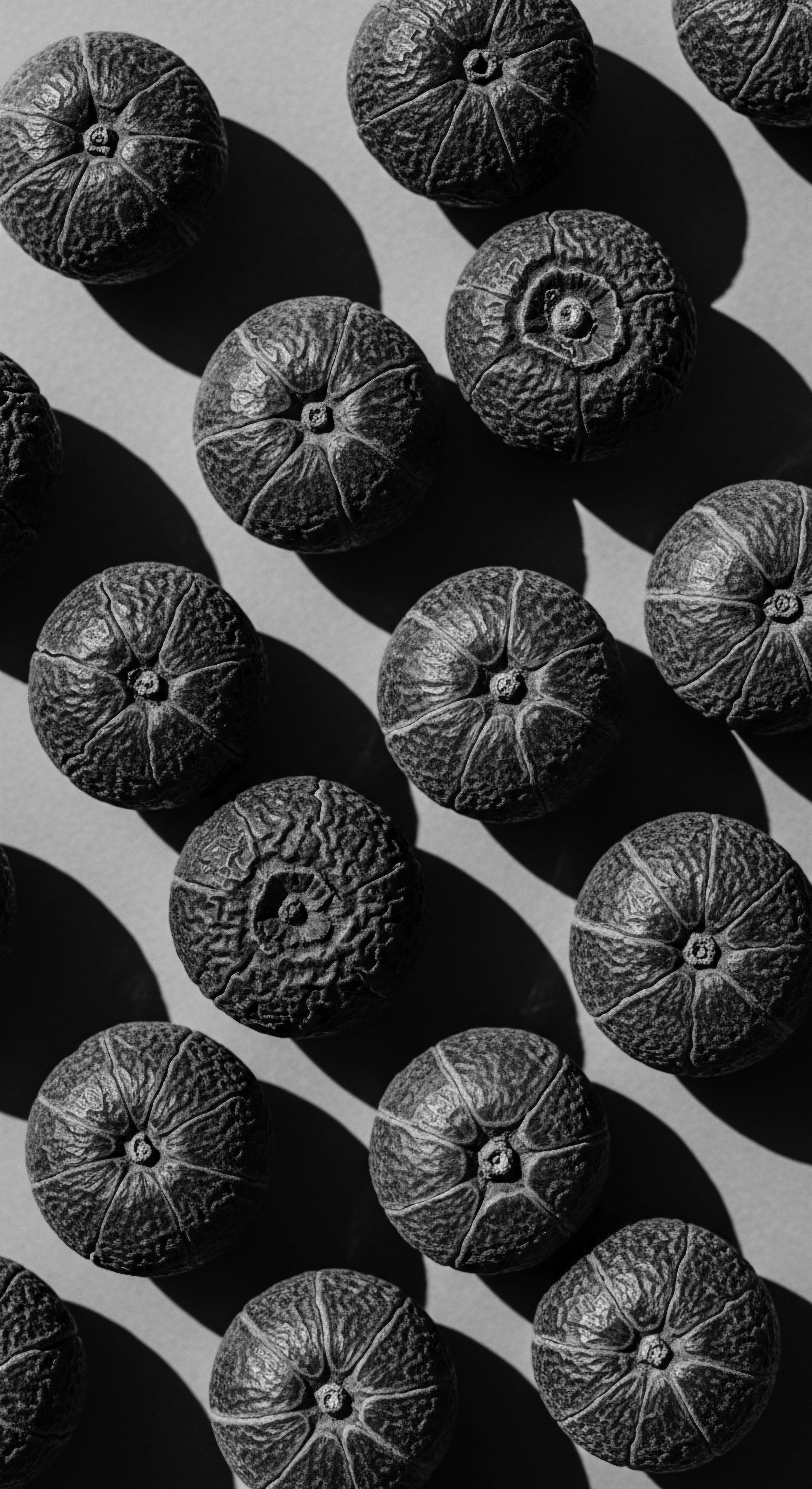
Intermediate
Moving beyond the fundamental alteration of hair bonds, the intermediate understanding of Chemical Hair Straightening involves a closer examination of the chemical agents at play and their historical progression, particularly within the context of textured hair heritage. This involves recognizing the specific compounds that facilitate the structural change and the varied effects they have on the hair fiber, all while acknowledging the social landscapes that shaped their adoption and continued use. The significance of this practice extends beyond mere cosmetic change, touching upon narratives of identity, adaptation, and societal pressure within Black and mixed-race communities.
The primary chemical agents employed in straightening systems historically fall into categories based on their active ingredients. Lye-Based Relaxers, often containing sodium hydroxide, are known for their potency and efficiency in breaking disulfide bonds. They achieve a dramatic straightening effect.
Alternatively, No-Lye Relaxers, which typically use calcium hydroxide and guanidine carbonate, present a milder, though still effective, alternative. While these formulations might seem purely scientific, their development and marketing were deeply intertwined with the lived experiences of individuals seeking to navigate societal beauty standards.
Consider the historical backdrop of the early 20th century, a period when the concept of “good hair” often equated to hair that mimicked European textures. This societal construct placed immense pressure on Black women and girls to alter their natural hair. Chemical hair straightening became a widespread method to conform, offering a more lasting solution than temporary heat methods like hot combs. This was not simply a choice of style; it was often a strategic decision for social acceptance and economic opportunity, reflecting the profound import hair held in navigating a prejudiced world.
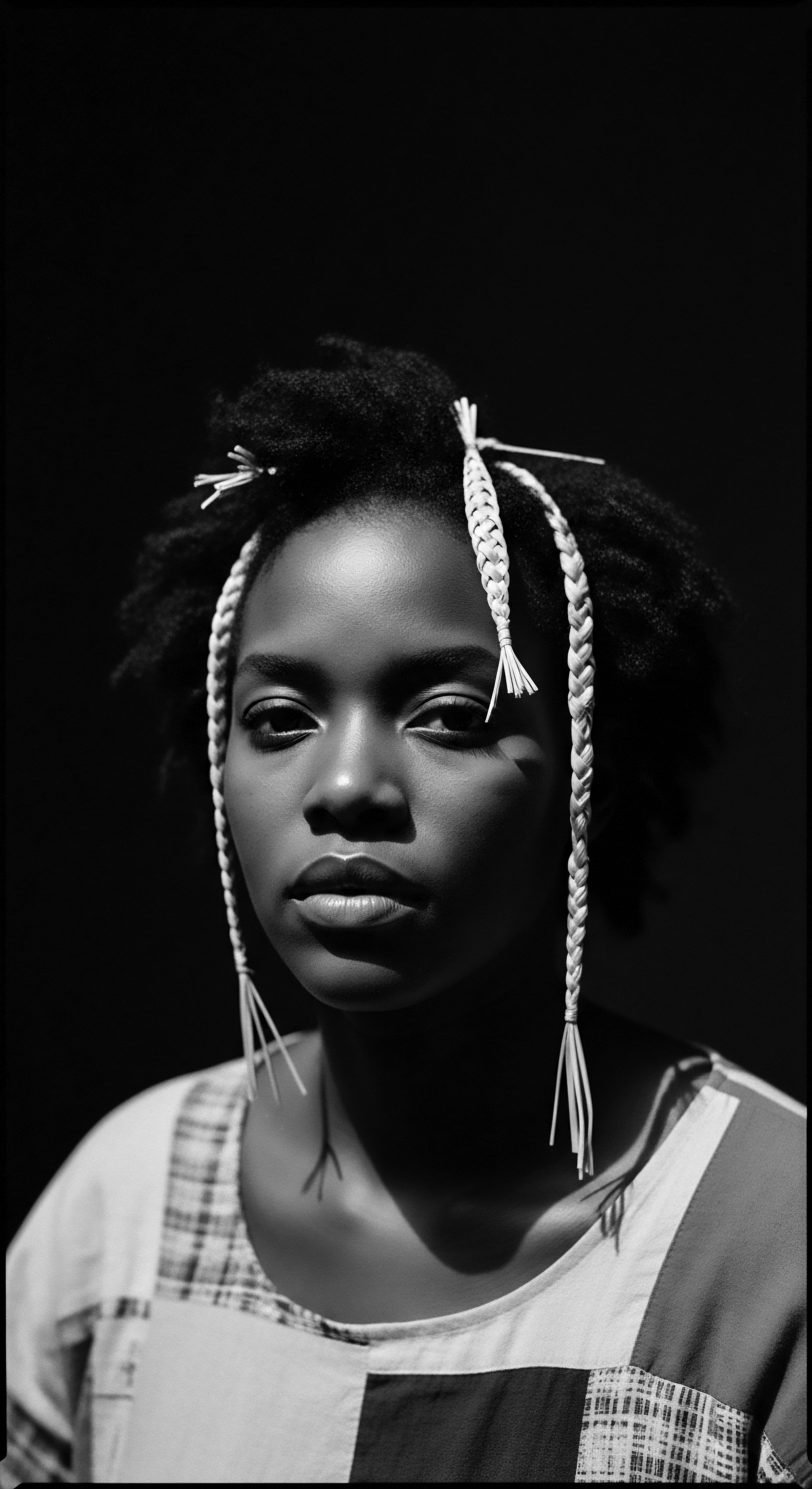
Evolution of Formulations and Their Cultural Footprint
The evolution of chemical straightening products mirrors a complex dance between scientific innovation and cultural demand. Early formulations were often harsh, causing scalp burns and hair damage. Yet, their widespread use persisted due to the perceived benefits of straightened hair in a society that valued Eurocentric aesthetics.
This sustained demand spurred manufacturers, including pioneering Black entrepreneurs, to refine these products, seeking less damaging yet effective solutions. The history of these formulations is a testament to the resilience and adaptability of Black communities in shaping their beauty practices.
- Sodium Hydroxide (Lye) Formulations ❉ These strong alkaline agents swiftly break the disulfide bonds, resulting in highly straightened hair. They require precise application and professional handling to minimize scalp irritation. The use of lye-based relaxers was widespread, particularly in professional salon settings, for their powerful straightening capabilities.
- Calcium Hydroxide/Guanidine Carbonate (No-Lye) Formulations ❉ Developed as a gentler alternative, these systems create guanidine hydroxide in situ, offering a less irritating experience for many. They became popular for at-home use, expanding access to chemical straightening beyond professional salons.
- Ammonium Thioglycolate Formulations ❉ Though more commonly associated with permanent waving (perms), certain concentrations of thioglycolate can also achieve straightening by breaking and then reforming disulfide bonds. These are often considered less aggressive than hydroxide-based systems.
The proliferation of these products, particularly the accessible no-lye options, meant that chemical hair straightening became an even more entrenched practice. It shaped rituals within homes and salons, creating spaces where generations learned about hair care, beauty, and conformity. The sensory experience of a relaxer application – the precise sectioning, the distinctive scent, the tingling sensation – became a shared cultural memory for many.
The intermediate understanding acknowledges that while the chemistry is universal, its application and significance are profoundly cultural. The meaning of chemical hair straightening, therefore, cannot be separated from the historical context of textured hair heritage, the societal pressures faced by Black and mixed-race individuals, and the continuous quest for self-expression within those parameters. This practice represents a complex interplay of scientific advancement, personal choice, and collective experience.
The journey of chemical straightening from harsh lye to milder no-lye formulations reflects not only scientific progress but also the persistent cultural pressures and aspirations for manageability and acceptance within textured hair communities.
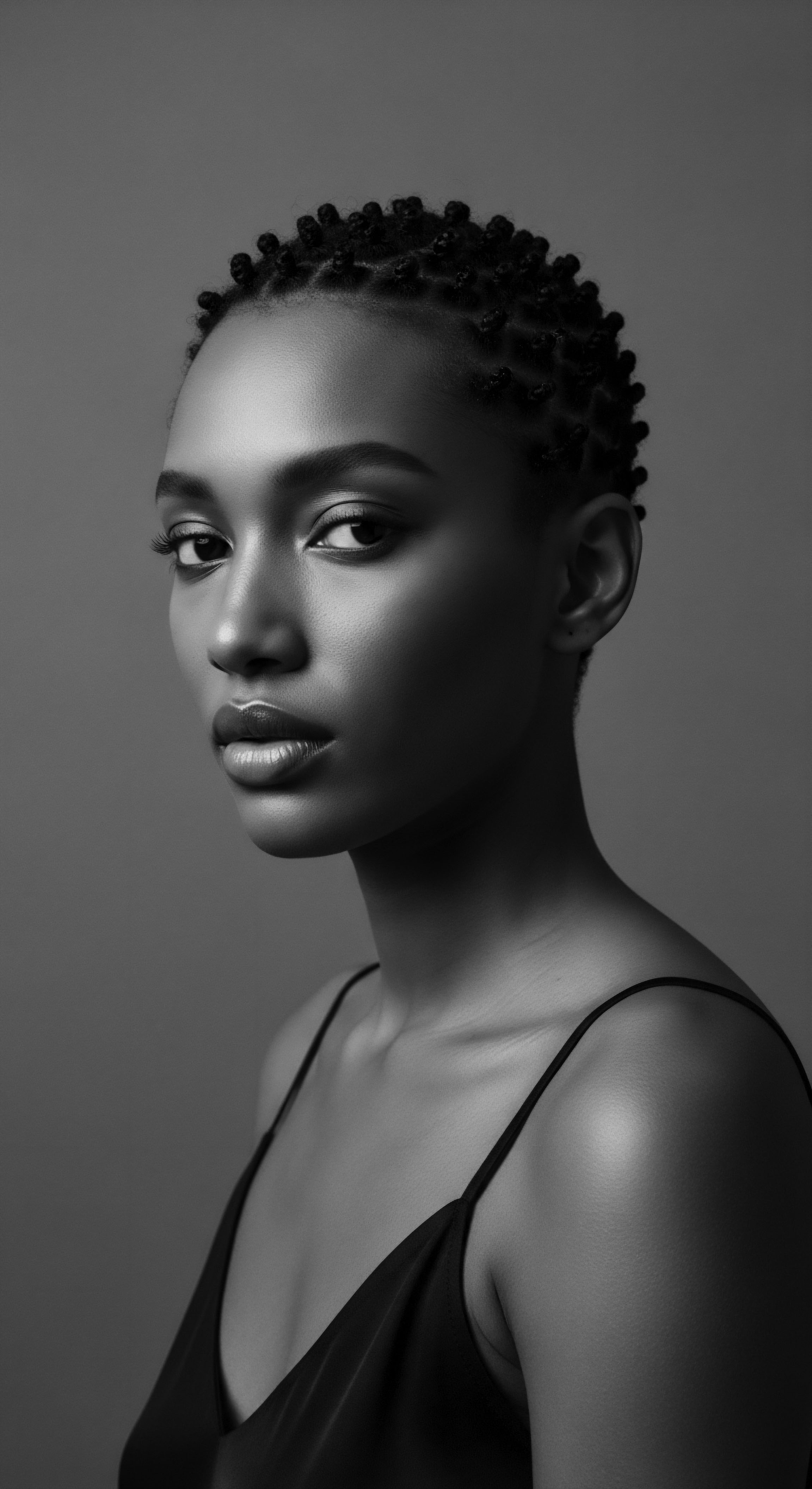
Academic
The academic delineation of Chemical Hair Straightening transcends superficial cosmetic alteration, positioning it as a profound socio-chemical phenomenon deeply intertwined with the biological anthropology of hair, the historical sociology of beauty, and critical public health considerations within the African diaspora. It is a process that fundamentally reorganizes the hair’s proteinaceous architecture, specifically targeting the disulfide bonds within the keratin polypeptide chains. This chemical disruption, often termed lanthionization in hydroxide-based systems, converts cystine disulfide bonds into lanthionine bonds, resulting in a permanent and irreversible change to the hair fiber’s tertiary structure, thereby eradicating its natural curl pattern. The meaning of this transformation, from a scholarly perspective, extends into domains of racial identity, systemic discrimination, and the physiological consequences of beauty standards.
The scientific underpinning of chemical hair straightening involves a delicate balance of chemical kinetics and structural biology. Alkaline agents, such as sodium hydroxide (lye) or guanidine hydroxide (no-lye), function by raising the pH of the hair, causing the cuticle scales to swell and lift, thereby allowing the active ingredient to penetrate the cortex. Within the cortex, these highly alkaline substances hydrolyze the disulfide bonds, effectively breaking the cross-linkages that dictate the hair’s coiled morphology. The hair then becomes pliable, allowing for mechanical straightening.
Subsequent neutralization and rinsing aim to lower the pH, facilitating the reformation of new, albeit fewer and structurally different, bonds in the straightened configuration. This process, while chemically precise, carries inherent risks to the hair shaft’s integrity and the scalp’s epidermal barrier.
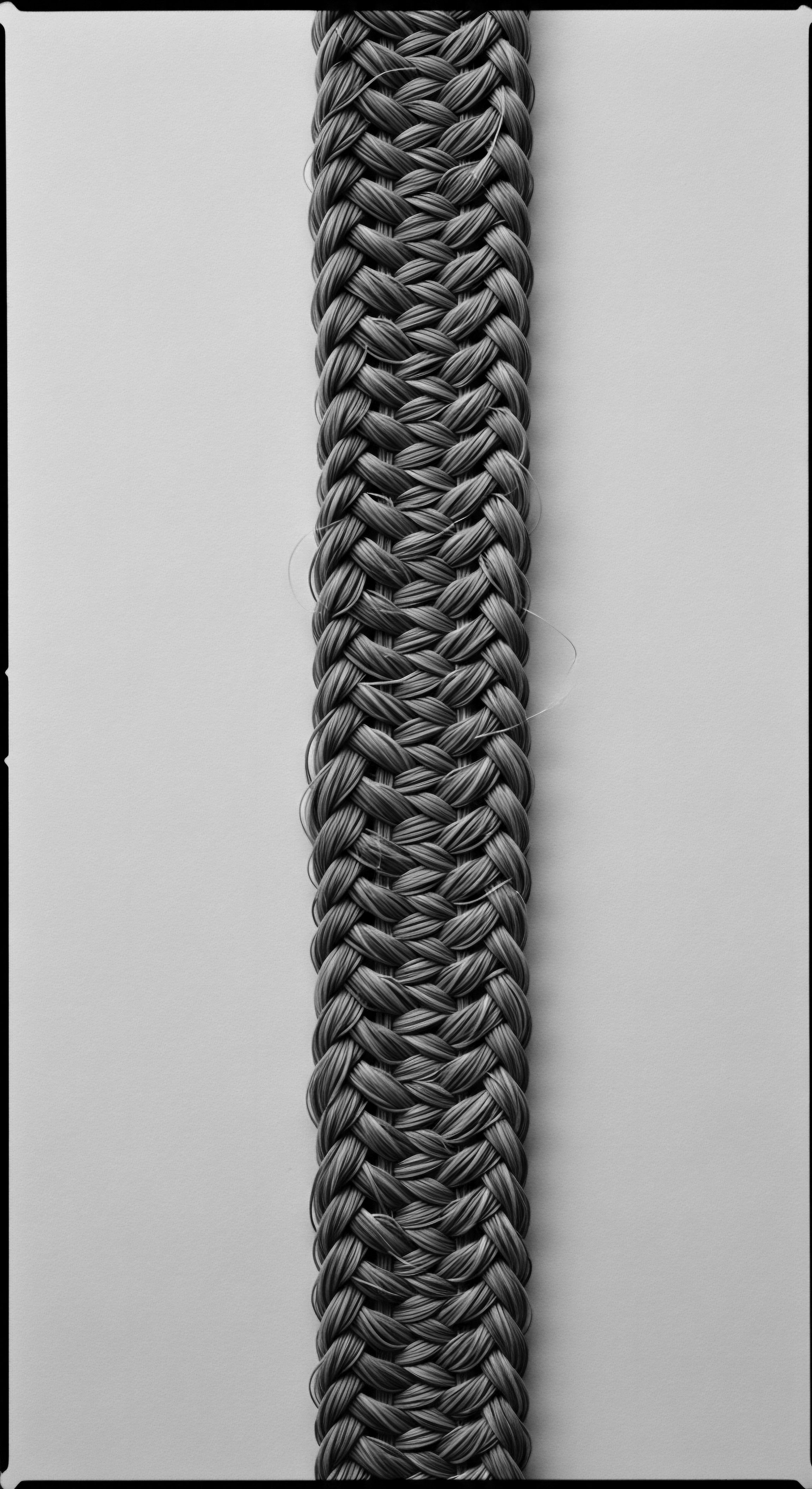
Multicultural Dimensions and Health Disparities
The application and cultural reception of chemical hair straightening are not uniform across global populations; rather, they are acutely stratified along lines of race and ethnicity, particularly within communities of African descent. Historically, the pressure to conform to Eurocentric beauty ideals, where straight hair is often valorized as “professional” or “desirable,” has profoundly influenced the widespread adoption of these chemical treatments among Black and mixed-race individuals. This phenomenon is not merely a matter of aesthetic preference; it is a manifestation of systemic biases and the historical legacy of slavery and colonialism, which denigrated natural Afro-textured hair as “unruly” or “unacceptable.”
A critical examination of this practice reveals significant health disparities. Studies have consistently pointed to an elevated risk of various adverse health outcomes among frequent users of chemical hair straighteners, predominantly Black women. These health implications underscore a profound intersection of historical societal pressures and contemporary public health concerns.
Chemical Hair Straightening, beyond its cosmetic application, represents a complex intersection of hair science, cultural assimilation, and critical public health challenges disproportionately affecting textured hair communities.
For instance, a compelling body of research has investigated the association between chemical hair relaxer use and the incidence of uterine fibroids, benign growths that disproportionately affect Black women. A significant contribution to this understanding comes from the work of Wise, Palmer, and Rosenberg (2012), who, drawing from the extensive data of the Black Women’s Health Study, reported a notable association. Their findings indicated that ever-use of hair relaxers among Black women was associated with a 17% higher incidence of uterine fibroids (OR, 1.17; 95% CI, 1.06, 1.30), with a clear trend observed for increased risk corresponding to greater frequency and duration of use (Wise et al. 2012, p.
117). This specific finding illuminates a critical aspect of the long-term consequences of these beauty practices, suggesting a link between chemical exposures and reproductive health outcomes that are more prevalent in this demographic.
The implications of such findings extend beyond individual health to broader discussions of environmental justice and the regulation of cosmetic products. Many chemical relaxers contain endocrine-disrupting chemicals (EDCs) and carcinogens, which can be absorbed through the scalp, particularly when irritation or burns occur during application. The continuous, often early-age, exposure to these compounds over a lifetime raises serious questions about the cumulative health burden on communities where these products have been culturally normative for generations.
The academic lens also considers the psychological and social ramifications. The enduring societal pressure to straighten textured hair has contributed to internalized texturism and a complex relationship with natural hair. For many, the choice to chemically straighten hair was not entirely autonomous but influenced by a desire for social mobility, professional acceptance, and a sense of belonging in environments that often penalized natural hair expressions. This historical context provides a deeper meaning to the practice, moving it from a simple aesthetic choice to a survival strategy within a biased social structure.
The academic inquiry into chemical hair straightening therefore necessitates a multidisciplinary approach, drawing from chemistry to explain molecular interactions, sociology to understand cultural pressures, history to trace ancestral practices and their evolution, and public health to address the health disparities that have emerged. It seeks to understand not just ‘what’ chemical hair straightening is, but ‘why’ it has been so deeply embedded in the heritage of textured hair and ‘what’ its long-term societal and physiological effects truly are.

Interconnected Incidences and Long-Term Consequences
The historical trajectory of chemical hair straightening reveals a pattern of interconnected incidences, where product innovation, marketing strategies, and societal norms reinforced each other. Early 20th-century advertisements often framed natural hair as “unmanageable” or “unprofessional,” thereby creating a market for straightening solutions. This marketing, coupled with real-world discrimination against natural hair in workplaces and schools, solidified the practice as a means of social navigation. The consequences of this normalization are now being rigorously examined.
| Aspect Motivation for Use |
| Historical Context (Early 20th Century) Assimilation into Eurocentric beauty standards; perceived social and economic advantage; manageability. |
| Contemporary Understanding (21st Century) Continued societal pressure in some professional/social settings; personal preference; historical habit; ease of styling. |
| Aspect Product Formulation |
| Historical Context (Early 20th Century) Often harsh lye-based (sodium hydroxide) formulas; limited understanding of long-term effects. |
| Contemporary Understanding (21st Century) Lye and no-lye (guanidine hydroxide, calcium hydroxide) options; increasing awareness of endocrine-disrupting chemicals (EDCs) and carcinogens. |
| Aspect Health Outcomes |
| Historical Context (Early 20th Century) Immediate scalp burns, hair breakage, dryness. |
| Contemporary Understanding (21st Century) Increased risk of uterine fibroids, uterine cancer, breast cancer, and other reproductive health issues (Wise et al. 2012); traction alopecia, central centrifugal cicatricial alopecia (CCCA). |
| Aspect Cultural Impact |
| Historical Context (Early 20th Century) Creation of "good hair" vs. "bad hair" dichotomy; shaping of beauty rituals within Black homes and salons. |
| Contemporary Understanding (21st Century) Ongoing natural hair movement as a form of resistance and self-affirmation; legal protections (CROWN Act) addressing hair discrimination. |
| Aspect This table highlights the evolving understanding of chemical hair straightening, underscoring its enduring significance within the heritage of textured hair and the ongoing efforts to address its multifaceted impacts. |
The widespread use of chemical hair straighteners has not only impacted physical health but has also left an indelible mark on the collective psyche and cultural practices within Black and mixed-race communities. The meaning of hair, once a vibrant marker of identity and spiritual connection in many African societies, became entangled with notions of conformity and survival in the diaspora. The legacy of this transformation continues to shape contemporary conversations about hair, beauty, and well-being.
Academic discourse also examines the concept of “hair politics,” where hair choices become deeply politicized statements. The decision to relax hair, or conversely, to wear it naturally, often carries implicit or explicit social meanings within Black communities and in the broader society. This critical perspective acknowledges that while chemical hair straightening offers a certain aesthetic, it also represents a complex negotiation with historical and ongoing systemic pressures that demand a specific appearance for acceptance.

Reflection on the Heritage of Chemical Hair Straightening
As we conclude this exploration of Chemical Hair Straightening, we find ourselves standing at a crossroads of history, science, and the enduring spirit of textured hair. The journey of this practice, from its rudimentary origins to its complex modern iterations, is more than a technical narrative; it is a profound meditation on adaptation, resilience, and the relentless human pursuit of belonging. Within Roothea’s living library, this entry serves as a vibrant archive, holding the echoes of ancestral whispers, the tactile memory of generations of care, and the evolving scientific understanding of hair itself.
The Soul of a Strand ethos calls us to witness the intricate dance between external pressures and internal strength. Chemical hair straightening, while often viewed through the lens of conformity, also speaks to the ingenious ways communities have navigated challenging landscapes. It is a testament to the resourcefulness that led to early attempts at hair alteration, a testament to the desire for ease in a world that often demanded immense effort, and, at times, a testament to the longing for a semblance of control in circumstances that offered little.
This practice, though born from a specific chemical intervention, has always been woven into the larger fabric of hair heritage. It stands as a powerful reminder of how deeply hair is intertwined with identity, not just individual identity, but the collective identity of a people. The decisions made around hair, whether to straighten, to braid, to loc, or to wear it in its natural glory, are never isolated acts. They are conversations with the past, responses to the present, and silent declarations for the future.
The story of Chemical Hair Straightening is a vibrant chapter in the heritage of textured hair, revealing layers of adaptation, societal negotiation, and the enduring quest for self-expression.
In the gentle unfolding of time, the meaning of chemical hair straightening continues to shift. What was once a near-universal practice for many Black women, driven by the desire for social acceptance, is now increasingly balanced by a powerful movement to embrace natural textures. This contemporary shift does not erase the historical significance of straightening; rather, it adds new layers to its meaning, allowing for a deeper appreciation of the choices made by previous generations and the wisdom gained through their experiences.
The tender thread of care, passed down through matriarchal lines, remains unbroken. Whether it was the careful application of a hot comb, the meticulous sectioning for a relaxer, or the patient tending of natural coils, the act of hair care has always been a ritual of connection and love. The understanding of chemical hair straightening, therefore, finds its most resonant place when viewed through this lens of inherited wisdom and the continuous dialogue between ancestral practices and contemporary realities. The journey of hair, in all its forms, is a sacred narrative, unfolding with every strand, every texture, and every generation.
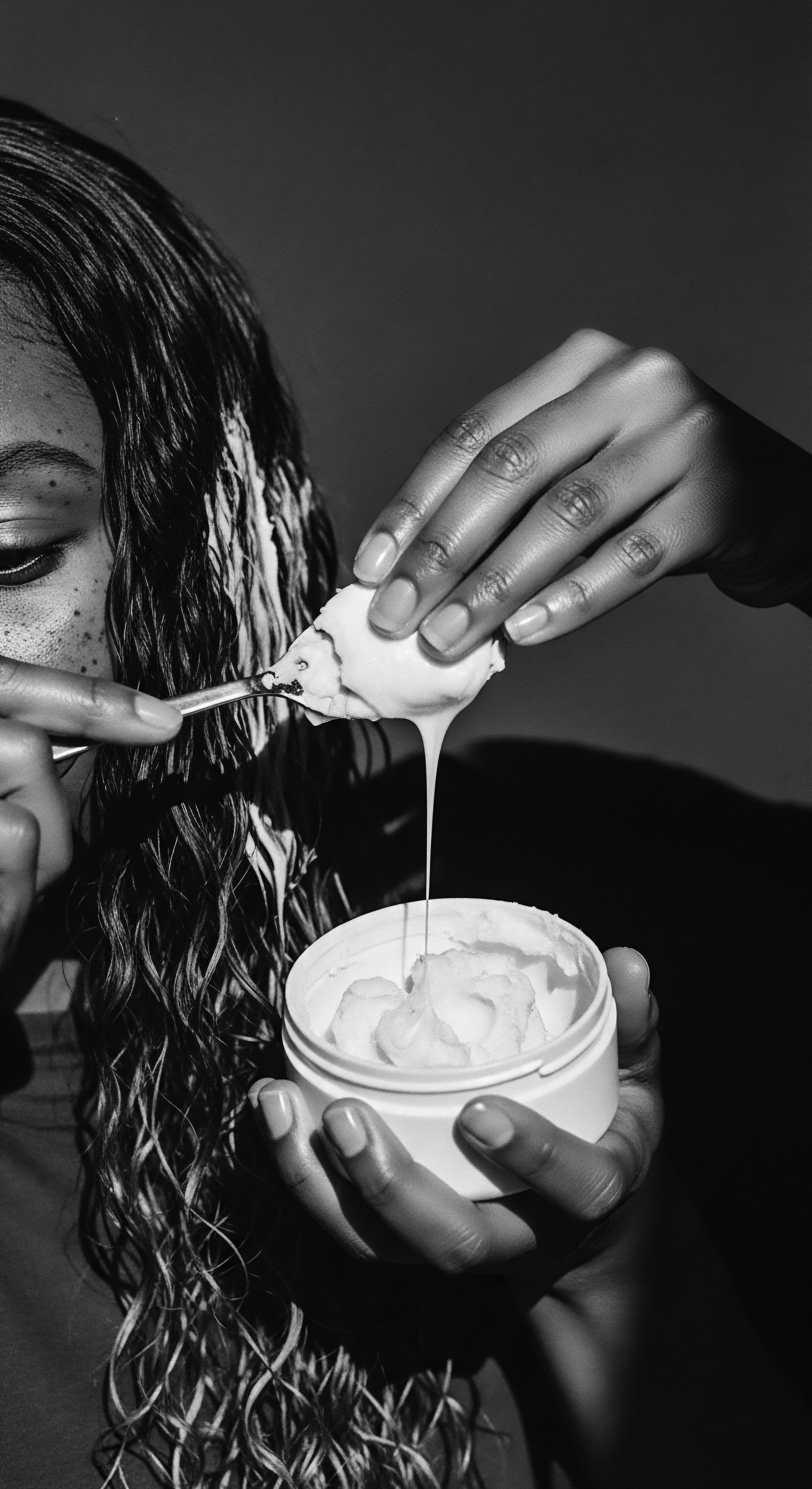
References
- Wise, L. A. Palmer, J. R. & Rosenberg, L. (2012). Hair relaxer use and risk of uterine leiomyomata in African-American women. American Journal of Epidemiology, 175(11), 1156-1164.
- Byrd, A. D. & Tharps, L. D. (2014). Hair Story ❉ Untangling the Roots of Black Hair in America. St. Martin’s Press.
- Hunter, T. (2011). Beauty Shop Politics ❉ African American Women’s Quest for Racial Agency. University of Illinois Press.
- Mercer, K. (1994). Welcome to the Jungle ❉ New Positions in Black Cultural Studies. Routledge.
- James-Todd, T. et al. (2011). Childhood hair product use and earlier age at menarche in a racially diverse study population ❉ a pilot study. Annals of Epidemiology, 21(6), 461-465.
- Collins, P. H. (2004). Black Sexual Politics ❉ African Americans, Gender, and the New Racism. Routledge.
- Grier, W. H. & Cobbs, P. M. (1968). Black Rage. Basic Books.
- Riggs, M. T. (1987). Ethnic Notions. California Newsreel.
